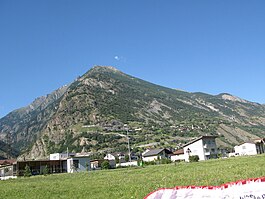Gampel
| Gampel | ||
|---|---|---|
| Former municipality of Switzerland | ||

Gampel village
|
||
|
||
| Coordinates: 46°19′N 7°45′E / 46.317°N 7.750°ECoordinates: 46°19′N 7°45′E / 46.317°N 7.750°E | ||
| Country | Switzerland | |
| Canton | Valais | |
| District | Leuk | |
| Area | ||
| • Total | 16.9 km2 (6.5 sq mi) | |
| Elevation | 634 m (2,080 ft) | |
| Population | ||
| • Total | 1,385 | |
| • Density | 82/km2 (210/sq mi) | |
| Postal code | 3945 | |
| SFOS number | 6107 | |
| Surrounded by | Bratsch, Erschmatt, Ferden, Niedergesteln, Steg, Turtmann | |
| Website |
www SFSO statistics |
|
Gampel is a former municipality in the district of Leuk in the canton of Valais in Switzerland.
It was an independent municipality until January 1, 2009, when it merged with Bratsch to form Gampel-Bratsch.
Gampel is first mentioned in 1238 as Champilz.
The blazon of the village coat of arms is Azure in dexter a Mullet of Six Or in sinister an Increscent inverted Argent in base Coupeaux of the second.
Gampel has a population (as of December 2002[update]) of 1,385.
Most of the population (as of 2000[update]) speaks German (1,188 or 91.3%) as their first language, Albanian is the second most common (33 or 2.5%) and Serbo-Croatian is the third (25 or 1.9%). There are 15 people who speak French, 22 people who speak Italian.
Of the population in the village 662 or about 50.9% were born in Gampel and lived there in 2000. There were 388 or 29.8% who were born in the same canton, while 65 or 5.0% were born somewhere else in Switzerland, and 151 or 11.6% were born outside of Switzerland. As of 2000[update], there were 547 people who were single and never married in the village. There were 681 married individuals, 50 widows or widowers and 23 individuals who are divorced.
There were 147 households that consist of only one person and 44 households with five or more people. Out of a total of 520 households that answered this question, 28.3% were households made up of just one person and there were 5 adults who lived with their parents. Of the rest of the households, there are 127 married couples without children, 199 married couples with children There were 23 single parents with a child or children. There were 4 households that were made up of unrelated people and 15 households that were made up of some sort of institution or another collective housing.
...
Wikipedia



